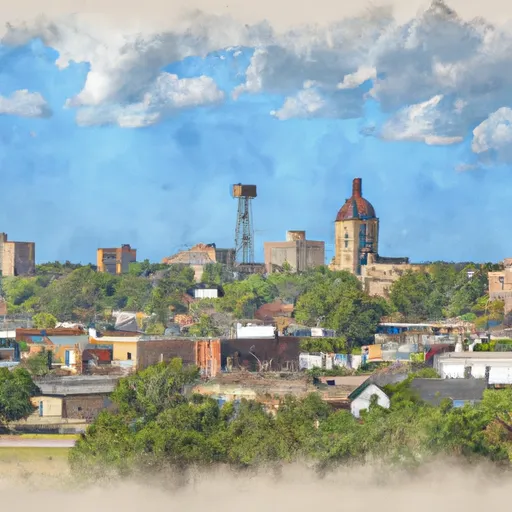-
 Snoflo Premium
Snoflo Premium
Get unlimited access to all our content
With no Ad interruptions! - Start Your Free Trial Login with existing account
Lake-City
Eden Index
Climate
8.2
•
Recreation
•
Community
•
Safeguard
3.3/10

Lake-City, Kansas is a charming town located in the heart of the state. The climate of Lake-City is characterized by hot summers and cold winters. Summers are typically hot and humid, with temperatures averaging in the high 80s to low 90s Fahrenheit. Winters can be bitterly cold, with average temperatures ranging from the low 20s to the mid-30s Fahrenheit. Lake-City experiences moderate rainfall throughout the year, with the wettest months occurring in spring and summer.
The town is known for its breathtaking lake, which provides various hydrology constituents. The lake serves as a reservoir for the community, supplying drinking water and irrigation for local farms. It also offers recreational activities such as boating, fishing, and swimming. Anglers can enjoy catching a variety of fish species, including bass, catfish, and crappie.
Outdoor enthusiasts will find an array of opportunities to explore in Lake-City. The surrounding areas boast scenic hiking trails, perfect for nature lovers and avid hikers. Additionally, the lake provides an excellent setting for picnicking and camping, with several campgrounds offering stunning views of the water.
In summary, Lake-City, Kansas offers a diverse climate with distinct seasons. Its beautiful lake serves as a vital hydrological resource and provides numerous outdoor recreation opportunities for visitors and locals alike.
What is the Eden Index?
The Snoflo Eden Index serves as a comprehensive rating system for regions, evaluating their desirability through a holistic assessment of climate health, outdoor recreation opportunities, and natural disaster risk, acknowledging the profound impact of these factors on livability and well-being.
Climate Health Indicator (CHI): 8.2
Lake-City receives approximately
683mm of rain per year,
with humidity levels near 81%
and air temperatures averaging around
14°C.
Lake-City has a plant hardyness factor of
6, meaning
plants and agriculture in this region thrive during a short period during spring and early summer. Most
plants will die off during the colder winter months.
By considering the ideal temperature range, reliable water supplies, clean air, and stable seasonal rain or snowpacks, the Climate Health Indicator (CHI) underscores the significance of a healthy climate as the foundation for quality living.
A healthy climate is paramount for ensuring a high quality of life and livability in a region, fostering both physical well-being and environmental harmony. This can be characterized by ideal temperatures, reliable access to water supplies, clean air, and consistent seasonal rain or snowpacks.
Weather Forecast
Streamflow Conditions
Arkansas - Keystone
Area Rivers
Arkansas - Keystone
Snowpack Depths
Arkansas - Keystone
Reservoir Storage Capacity
Arkansas - Keystone
Groundwater Levels
Recreational Opportunity Index (ROI):
The Recreational Opportunity Index (ROI) recognizes the value of outdoor recreational options, such as parks, hiking trails, camping sites, and fishing spots, while acknowledging that climate plays a pivotal role in ensuring the comfort and consistency of these experiences.
Access to outdoor recreational opportunities, encompassing activities such as parks, hiking, camping, and fishing, is crucial for overall well-being, and the climate plays a pivotal role in enabling and enhancing these experiences, ensuring that individuals can engage in nature-based activities comfortably and consistently.
Camping Areas
| Campground | Campsites | Reservations | Toilets | Showers | Elevation |
|---|---|---|---|---|---|
| Hoisington Park | 12 | 1,836 ft | |||
| Pratt County Veterans Memorial Park | 17 | 1,811 ft | |||
| Little Sahara State Park | None | 1,463 ft |
Nearby Ski Areas
Catastrophe Safeguard Index (CSI):
The Catastrophe Safeguard Index (CSI) recognizes that natural disaster risk, encompassing floods, fires, hurricanes, and tornadoes, can drastically affect safety and the overall appeal of an area.
The level of natural disaster risk in a region significantly affects safety and the overall livability, with climate change amplifying these risks by potentially increasing the frequency and intensity of events like floods, fires, hurricanes, and tornadoes, thereby posing substantial challenges to community resilience and well-being.
Community Resilience Indicator (CRI):
The Community Resilience Indicator (CRI) recognizes that education, healthcare, and socioeconomics are crucial to the well-being of a region. The CRI acknowledges the profound impact of these elements on residents' overall quality of life. By evaluating educational resources, healthcare accessibility, and economic inclusivity, the index captures the essential aspects that contribute to a thriving community, fostering resident satisfaction, equity, and social cohesion.

